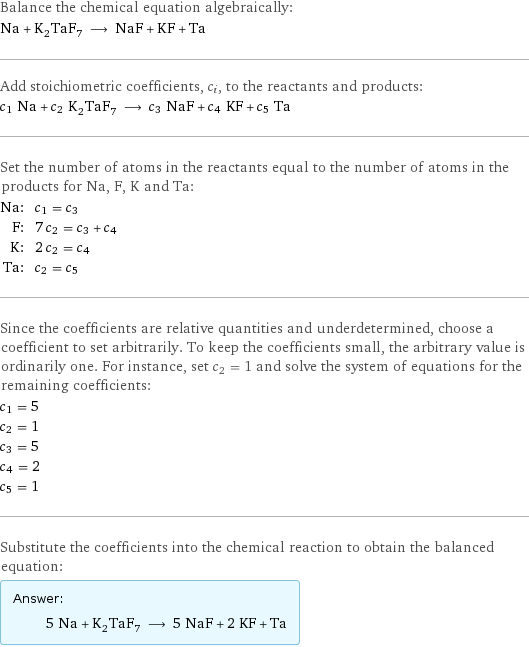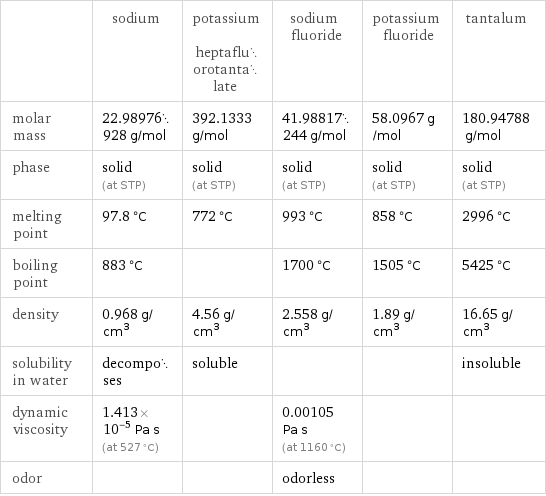Input interpretation

Na sodium + K_2TaF_7 potassium heptafluorotantalate ⟶ NaF sodium fluoride + KF potassium fluoride + Ta tantalum
Balanced equation

Balance the chemical equation algebraically: Na + K_2TaF_7 ⟶ NaF + KF + Ta Add stoichiometric coefficients, c_i, to the reactants and products: c_1 Na + c_2 K_2TaF_7 ⟶ c_3 NaF + c_4 KF + c_5 Ta Set the number of atoms in the reactants equal to the number of atoms in the products for Na, F, K and Ta: Na: | c_1 = c_3 F: | 7 c_2 = c_3 + c_4 K: | 2 c_2 = c_4 Ta: | c_2 = c_5 Since the coefficients are relative quantities and underdetermined, choose a coefficient to set arbitrarily. To keep the coefficients small, the arbitrary value is ordinarily one. For instance, set c_2 = 1 and solve the system of equations for the remaining coefficients: c_1 = 5 c_2 = 1 c_3 = 5 c_4 = 2 c_5 = 1 Substitute the coefficients into the chemical reaction to obtain the balanced equation: Answer: | | 5 Na + K_2TaF_7 ⟶ 5 NaF + 2 KF + Ta
Structures

+ ⟶ + +
Names

sodium + potassium heptafluorotantalate ⟶ sodium fluoride + potassium fluoride + tantalum
Equilibrium constant
![Construct the equilibrium constant, K, expression for: Na + K_2TaF_7 ⟶ NaF + KF + Ta Plan: • Balance the chemical equation. • Determine the stoichiometric numbers. • Assemble the activity expression for each chemical species. • Use the activity expressions to build the equilibrium constant expression. Write the balanced chemical equation: 5 Na + K_2TaF_7 ⟶ 5 NaF + 2 KF + Ta Assign stoichiometric numbers, ν_i, using the stoichiometric coefficients, c_i, from the balanced chemical equation in the following manner: ν_i = -c_i for reactants and ν_i = c_i for products: chemical species | c_i | ν_i Na | 5 | -5 K_2TaF_7 | 1 | -1 NaF | 5 | 5 KF | 2 | 2 Ta | 1 | 1 Assemble the activity expressions accounting for the state of matter and ν_i: chemical species | c_i | ν_i | activity expression Na | 5 | -5 | ([Na])^(-5) K_2TaF_7 | 1 | -1 | ([K2TaF7])^(-1) NaF | 5 | 5 | ([NaF])^5 KF | 2 | 2 | ([KF])^2 Ta | 1 | 1 | [Ta] The equilibrium constant symbol in the concentration basis is: K_c Mulitply the activity expressions to arrive at the K_c expression: Answer: | | K_c = ([Na])^(-5) ([K2TaF7])^(-1) ([NaF])^5 ([KF])^2 [Ta] = (([NaF])^5 ([KF])^2 [Ta])/(([Na])^5 [K2TaF7])](../image_source/e1feec1a7915444ce0639c0c277e1c93.png)
Construct the equilibrium constant, K, expression for: Na + K_2TaF_7 ⟶ NaF + KF + Ta Plan: • Balance the chemical equation. • Determine the stoichiometric numbers. • Assemble the activity expression for each chemical species. • Use the activity expressions to build the equilibrium constant expression. Write the balanced chemical equation: 5 Na + K_2TaF_7 ⟶ 5 NaF + 2 KF + Ta Assign stoichiometric numbers, ν_i, using the stoichiometric coefficients, c_i, from the balanced chemical equation in the following manner: ν_i = -c_i for reactants and ν_i = c_i for products: chemical species | c_i | ν_i Na | 5 | -5 K_2TaF_7 | 1 | -1 NaF | 5 | 5 KF | 2 | 2 Ta | 1 | 1 Assemble the activity expressions accounting for the state of matter and ν_i: chemical species | c_i | ν_i | activity expression Na | 5 | -5 | ([Na])^(-5) K_2TaF_7 | 1 | -1 | ([K2TaF7])^(-1) NaF | 5 | 5 | ([NaF])^5 KF | 2 | 2 | ([KF])^2 Ta | 1 | 1 | [Ta] The equilibrium constant symbol in the concentration basis is: K_c Mulitply the activity expressions to arrive at the K_c expression: Answer: | | K_c = ([Na])^(-5) ([K2TaF7])^(-1) ([NaF])^5 ([KF])^2 [Ta] = (([NaF])^5 ([KF])^2 [Ta])/(([Na])^5 [K2TaF7])
Rate of reaction
![Construct the rate of reaction expression for: Na + K_2TaF_7 ⟶ NaF + KF + Ta Plan: • Balance the chemical equation. • Determine the stoichiometric numbers. • Assemble the rate term for each chemical species. • Write the rate of reaction expression. Write the balanced chemical equation: 5 Na + K_2TaF_7 ⟶ 5 NaF + 2 KF + Ta Assign stoichiometric numbers, ν_i, using the stoichiometric coefficients, c_i, from the balanced chemical equation in the following manner: ν_i = -c_i for reactants and ν_i = c_i for products: chemical species | c_i | ν_i Na | 5 | -5 K_2TaF_7 | 1 | -1 NaF | 5 | 5 KF | 2 | 2 Ta | 1 | 1 The rate term for each chemical species, B_i, is 1/ν_i(Δ[B_i])/(Δt) where [B_i] is the amount concentration and t is time: chemical species | c_i | ν_i | rate term Na | 5 | -5 | -1/5 (Δ[Na])/(Δt) K_2TaF_7 | 1 | -1 | -(Δ[K2TaF7])/(Δt) NaF | 5 | 5 | 1/5 (Δ[NaF])/(Δt) KF | 2 | 2 | 1/2 (Δ[KF])/(Δt) Ta | 1 | 1 | (Δ[Ta])/(Δt) (for infinitesimal rate of change, replace Δ with d) Set the rate terms equal to each other to arrive at the rate expression: Answer: | | rate = -1/5 (Δ[Na])/(Δt) = -(Δ[K2TaF7])/(Δt) = 1/5 (Δ[NaF])/(Δt) = 1/2 (Δ[KF])/(Δt) = (Δ[Ta])/(Δt) (assuming constant volume and no accumulation of intermediates or side products)](../image_source/8ec53b748c0d753638b7e7e1caac3875.png)
Construct the rate of reaction expression for: Na + K_2TaF_7 ⟶ NaF + KF + Ta Plan: • Balance the chemical equation. • Determine the stoichiometric numbers. • Assemble the rate term for each chemical species. • Write the rate of reaction expression. Write the balanced chemical equation: 5 Na + K_2TaF_7 ⟶ 5 NaF + 2 KF + Ta Assign stoichiometric numbers, ν_i, using the stoichiometric coefficients, c_i, from the balanced chemical equation in the following manner: ν_i = -c_i for reactants and ν_i = c_i for products: chemical species | c_i | ν_i Na | 5 | -5 K_2TaF_7 | 1 | -1 NaF | 5 | 5 KF | 2 | 2 Ta | 1 | 1 The rate term for each chemical species, B_i, is 1/ν_i(Δ[B_i])/(Δt) where [B_i] is the amount concentration and t is time: chemical species | c_i | ν_i | rate term Na | 5 | -5 | -1/5 (Δ[Na])/(Δt) K_2TaF_7 | 1 | -1 | -(Δ[K2TaF7])/(Δt) NaF | 5 | 5 | 1/5 (Δ[NaF])/(Δt) KF | 2 | 2 | 1/2 (Δ[KF])/(Δt) Ta | 1 | 1 | (Δ[Ta])/(Δt) (for infinitesimal rate of change, replace Δ with d) Set the rate terms equal to each other to arrive at the rate expression: Answer: | | rate = -1/5 (Δ[Na])/(Δt) = -(Δ[K2TaF7])/(Δt) = 1/5 (Δ[NaF])/(Δt) = 1/2 (Δ[KF])/(Δt) = (Δ[Ta])/(Δt) (assuming constant volume and no accumulation of intermediates or side products)
Chemical names and formulas

| sodium | potassium heptafluorotantalate | sodium fluoride | potassium fluoride | tantalum formula | Na | K_2TaF_7 | NaF | KF | Ta Hill formula | Na | F_7K_2Ta | FNa | FK | Ta name | sodium | potassium heptafluorotantalate | sodium fluoride | potassium fluoride | tantalum IUPAC name | sodium | dipotassium heptafluorotantalum | sodium fluoride | potassium fluoride | tantalum
Substance properties

| sodium | potassium heptafluorotantalate | sodium fluoride | potassium fluoride | tantalum molar mass | 22.98976928 g/mol | 392.1333 g/mol | 41.98817244 g/mol | 58.0967 g/mol | 180.94788 g/mol phase | solid (at STP) | solid (at STP) | solid (at STP) | solid (at STP) | solid (at STP) melting point | 97.8 °C | 772 °C | 993 °C | 858 °C | 2996 °C boiling point | 883 °C | | 1700 °C | 1505 °C | 5425 °C density | 0.968 g/cm^3 | 4.56 g/cm^3 | 2.558 g/cm^3 | 1.89 g/cm^3 | 16.65 g/cm^3 solubility in water | decomposes | soluble | | | insoluble dynamic viscosity | 1.413×10^-5 Pa s (at 527 °C) | | 0.00105 Pa s (at 1160 °C) | | odor | | | odorless | |
Units
